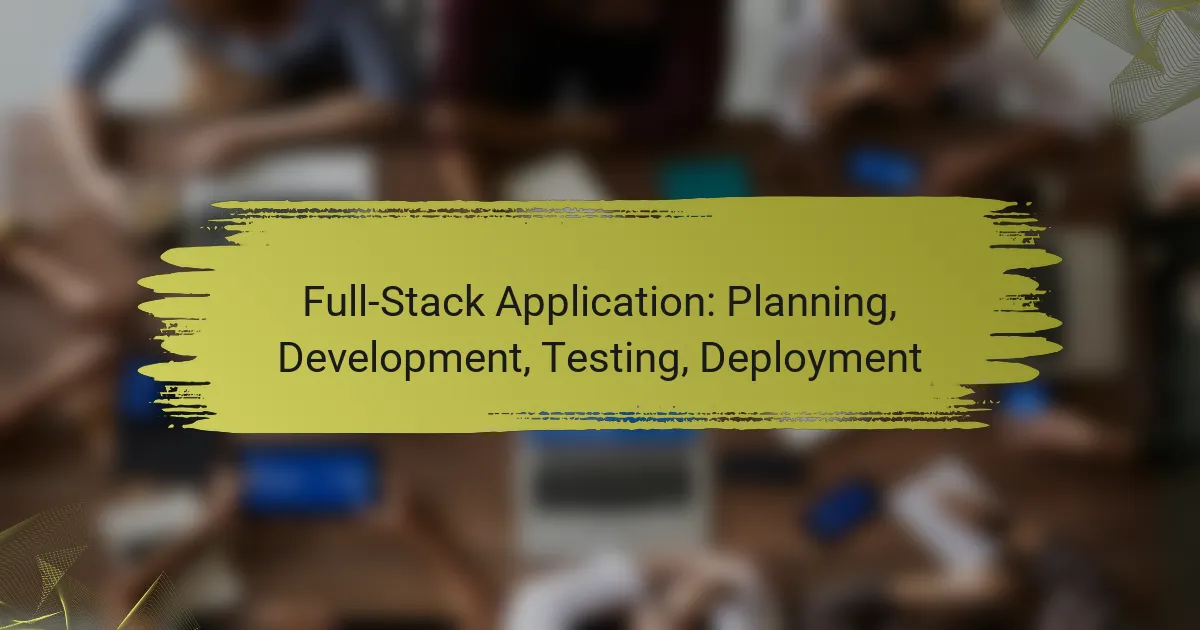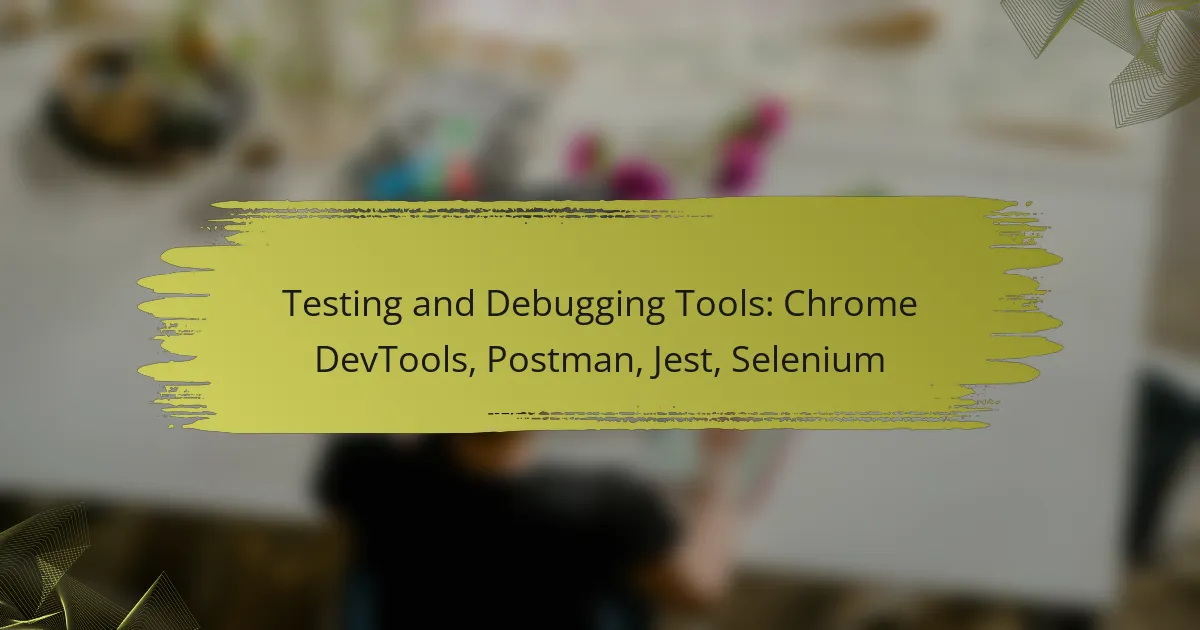Developing a full-stack application involves a comprehensive approach that encompasses planning, development, testing, and deployment. Key steps include defining the project scope, selecting the right technology stack, and creating prototypes to ensure alignment with user needs. Effective integration of front-end and back-end technologies is essential, along with rigorous testing practices to guarantee functionality and performance. By following best practices, developers can deliver robust applications that meet both user expectations and project timelines.

What are the key steps in full-stack application planning?
Key steps in full-stack application planning include defining the project scope, identifying the target audience, choosing the technology stack, creating wireframes and prototypes, and establishing a project timeline. Each step is crucial for ensuring that the application meets user needs and is delivered on time and within budget.
Define project scope
Defining the project scope involves outlining the features and functionalities that the application will include. This step helps to set clear expectations and limits, preventing scope creep during development. Use techniques like user stories or feature lists to clarify what is essential versus what is optional.
Consider creating a scope document that details the project objectives, deliverables, and constraints. This document serves as a reference point throughout the project lifecycle.
Identify target audience
Identifying the target audience is critical for tailoring the application to meet user needs effectively. Research demographics, preferences, and behaviors to understand who will use the application and why. This information can guide design and functionality decisions.
Utilize surveys, interviews, or market analysis to gather insights about potential users. Creating user personas can also help visualize the audience and their specific requirements.
Choose technology stack
Choosing the right technology stack is essential for the application’s performance, scalability, and maintainability. Consider factors such as the project requirements, team expertise, and long-term support when selecting technologies. Common stacks include MERN (MongoDB, Express, React, Node.js) and LAMP (Linux, Apache, MySQL, PHP).
Evaluate the pros and cons of each technology, including community support, documentation, and integration capabilities. This decision can significantly impact development speed and future updates.
Create wireframes and prototypes
Creating wireframes and prototypes allows for visualizing the application layout and user interface before development begins. Wireframes serve as blueprints, outlining the basic structure, while prototypes can simulate user interactions. This helps in identifying usability issues early on.
Tools like Figma, Sketch, or Adobe XD can be used to create these designs. Involve stakeholders in the review process to gather feedback and make necessary adjustments before finalizing the designs.
Establish project timeline
Establishing a project timeline helps in organizing tasks and setting deadlines for each phase of development. Break down the project into manageable milestones, and assign estimated completion dates to each. This approach aids in tracking progress and ensures accountability among team members.
Use project management tools like Trello or Asana to visualize the timeline and adjust it as needed. Regular check-ins can help identify potential delays and keep the project on track.

How to develop a full-stack application effectively?
To develop a full-stack application effectively, focus on a clear architecture that integrates front-end and back-end technologies seamlessly. Prioritize user experience, performance, and maintainability throughout the planning, development, testing, and deployment stages.
Front-end development with React
Front-end development using React involves building user interfaces with reusable components. React’s virtual DOM enhances performance by minimizing direct interactions with the actual DOM, leading to faster rendering times.
When developing with React, consider using tools like Create React App for quick setup and state management libraries like Redux for complex applications. Ensure your design is responsive to cater to various devices, and utilize CSS frameworks like Bootstrap or Tailwind for styling.
Back-end development with Node.js
Back-end development with Node.js allows for building scalable server-side applications using JavaScript. Its non-blocking architecture makes it suitable for handling multiple connections simultaneously, which is ideal for real-time applications.
When using Node.js, leverage frameworks like Express.js to streamline routing and middleware management. Pay attention to security practices, such as input validation and using HTTPS, to protect user data and maintain application integrity.
Database integration using MongoDB
Integrating MongoDB as your database solution provides a flexible, document-oriented approach to data storage. This NoSQL database allows for easy scaling and is particularly effective for applications with varying data structures.
When working with MongoDB, utilize Mongoose for schema validation and data modeling. Ensure you implement proper indexing to enhance query performance and consider data backup strategies to prevent data loss.
Implement RESTful APIs
Implementing RESTful APIs is crucial for enabling communication between the front-end and back-end of your application. RESTful APIs follow standard HTTP methods, making them easy to understand and integrate.
Focus on designing clear and consistent endpoints, and use proper status codes to convey the outcome of API requests. Document your API using tools like Swagger to facilitate easier integration for front-end developers and third-party services.

What are the best practices for testing full-stack applications?
Best practices for testing full-stack applications include a combination of unit testing, integration testing, and user acceptance testing. Each type of testing serves a specific purpose and helps ensure that the application functions correctly across different layers.
Unit testing with Jest
Unit testing with Jest focuses on individual components or functions to verify their correctness in isolation. This type of testing is essential for catching bugs early in the development process, as it allows developers to ensure that each unit behaves as expected.
To implement unit tests with Jest, start by writing test cases for each function or component. Use assertions to check that the output matches the expected results. Aim for a coverage rate of at least 80% to ensure comprehensive testing.
Integration testing with Mocha
Integration testing with Mocha evaluates how different components of the application work together. This testing phase is crucial for identifying issues that may arise when various parts of the system interact, such as API calls or database connections.
When conducting integration tests, define clear scenarios that simulate real user interactions. Use Mocha’s capabilities to organize tests and manage asynchronous code effectively. Consider running these tests in a staging environment to closely mimic production conditions.
User acceptance testing
User acceptance testing (UAT) involves real users testing the application to ensure it meets their needs and requirements. This phase is vital for validating the application’s functionality and usability before it goes live.
To conduct UAT, gather a group of representative users and provide them with specific tasks to complete within the application. Collect feedback on their experience and any issues encountered. Aim to address any critical concerns before the final deployment to enhance user satisfaction.

How to deploy a full-stack application?
Deploying a full-stack application involves transferring your application from a local environment to a live server where users can access it. This process typically includes selecting a cloud service, setting up continuous integration and deployment (CI/CD) pipelines, and monitoring the application’s performance after launch.
Choose a cloud service like AWS
Selecting a cloud service is crucial for hosting your full-stack application. Amazon Web Services (AWS) is a popular choice due to its scalability, reliability, and a wide range of services that support various application needs.
When choosing a cloud provider, consider factors such as pricing, ease of use, and the specific services offered. Other options include Google Cloud Platform and Microsoft Azure, which also provide robust solutions for deploying applications.
Set up CI/CD pipelines with GitHub Actions
Continuous Integration and Continuous Deployment (CI/CD) pipelines automate the process of testing and deploying your application. GitHub Actions is a powerful tool that integrates seamlessly with your GitHub repositories, allowing you to define workflows that trigger on code changes.
To set up a CI/CD pipeline, create a workflow file in your repository that specifies the steps for building, testing, and deploying your application. This can significantly reduce deployment time and minimize human error.
Monitor application performance
After deployment, monitoring your application’s performance is essential to ensure it runs smoothly. Tools like AWS CloudWatch or Google Analytics can help track metrics such as response times, error rates, and user engagement.
Establish key performance indicators (KPIs) to evaluate your application’s success. Regularly reviewing these metrics allows you to identify issues early and make necessary adjustments to improve user experience.

What are the common challenges in full-stack development?
Full-stack development presents several challenges, including managing diverse technologies, ensuring seamless integration, and maintaining performance across platforms. Developers must navigate these complexities to deliver a cohesive user experience.
Managing cross-platform compatibility
Cross-platform compatibility is crucial in full-stack development as applications must function well on various devices and operating systems. This requires careful consideration of different browsers, screen sizes, and performance capabilities.
To ensure compatibility, developers should use responsive design techniques and test applications on multiple platforms. Frameworks like React Native or Flutter can help streamline this process by allowing code reuse across platforms.
Common pitfalls include neglecting to test on less popular browsers or devices, which can lead to a poor user experience. Regularly updating libraries and frameworks can also mitigate compatibility issues, as they often include fixes for known bugs and performance improvements.



